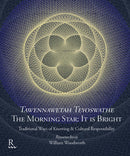Description
Traditional Ways of Knowing & Cultural Responsibility. A Prayer for Recovery & a Spiritual Explanation of the Process for Receiving Duties on Behalf of Oneself & All the People.
William (Bill) Woodworth is a member of the Lower Mohawk Kanien'kehá:ka Nation of Six Nations of the Grand River in the Bear Clan. Adopted into the Deer Clan of the Cayuga Nation he was named Raweno;kwas "he dips the words" in the Haudenausaunee tradition. Educated in architecture at the University of Michigan, Ann Arbor, he has an independent architectural practice and is an educator. His principle teacher there was the well known Latvian architect Gunnar Birkerts. William completed his doctoral work in Traditional Knowledge, Recovery of the Indigenous Mind, at the California Institute of Integral Studies, San Francisco. He studied under Dr. Apela Colorado and Jurgen Kremer.
The structure of this book and the stories in it are an attempt to connect my personal ordeal and awakenings with the enlarged collective transformative experience, and ultimately to clarify the workings of the imagination and the intentions behind creative action. The traditional understanding of duty and responsibility which is always communal, is shown to be a recoverable quality of personal identity in the modern world. By recounting in a profoundly reflective and interpretive way the patterns of my personal ancestral migrations forwarded into the present, the conceptualization and design of the ceremonies and ceremonial grounds which are the culmination of my work, demonstrate the power of memory as a source of imagination and vision.
The compassionate and equanimous inspiration for the renewal of the responsibilities inherent in ancient indigenous greeting ceremonies is shown to be a deep form of reconciliation among the first peoples of a land and subsequent visitors. Walking respectfully between my two worlds, ancestrally British and Hotinonshon:ni, and indeed among many other worlds, is shown to be fundamental to carrying out such responsibilities in the contemporary realm. The design of the architectonic setting and ritual structure for Toronto: A Beacon to the Ancestors are my reflections of this journey, inhabited by so many wise Elders and peers who have taught me.
Indeed my acts of creative imagination become my prayer, my offering, to be worthy of such a duty.


